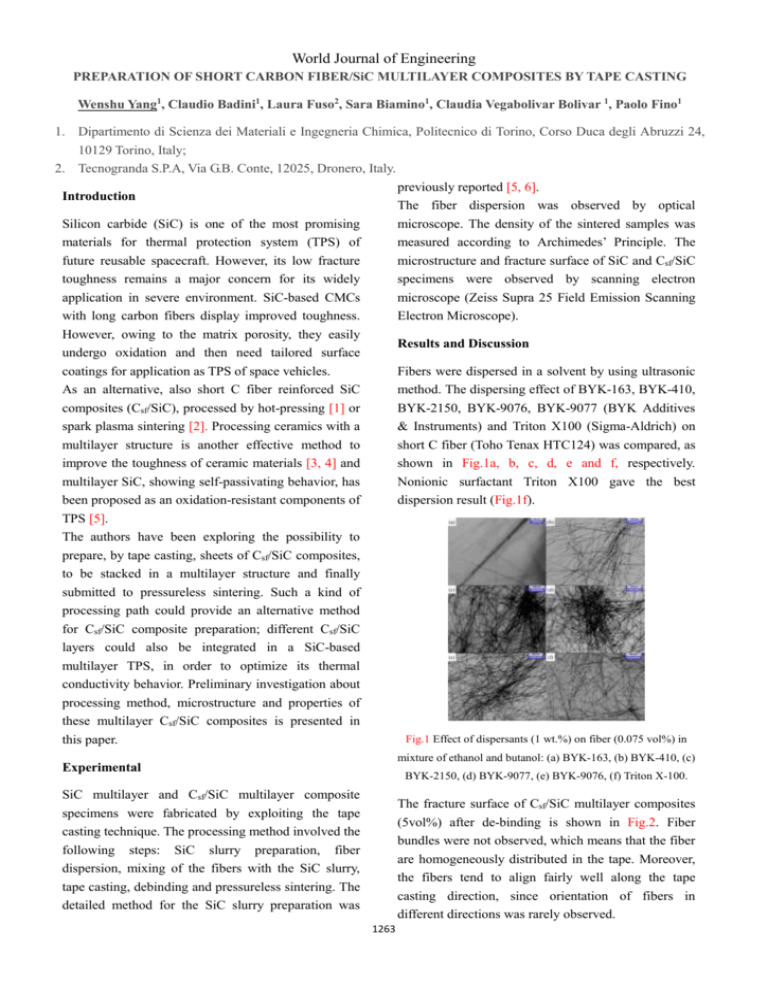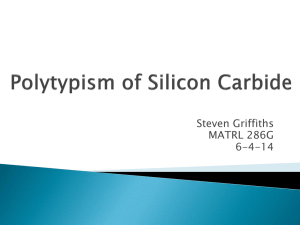PREPARATION OF SHORT CARBON FIBRE/SiC MULTILAYER
advertisement

World Journal of Engineering PREPARATION OF SHORT CARBON FIBER/SiC MULTILAYER COMPOSITES BY TAPE CASTING Wenshu Yang1, Claudio Badini1, Laura Fuso2, Sara Biamino1, Claudia Vegabolivar Bolivar 1, Paolo Fino1 1. Dipartimento di Scienza dei Materiali e Ingegneria Chimica, Politecnico di Torino, Corso Duca degli Abruzzi 24, 10129 Torino, Italy; 2. Tecnogranda S.P.A, Via G.B. Conte, 12025, Dronero, Italy. previously reported [5, 6]. Introduction The fiber dispersion was observed by optical Silicon carbide (SiC) is one of the most promising microscope. The density of the sintered samples was materials for thermal protection system (TPS) of measured according to Archimedes’ Principle. The future reusable spacecraft. However, its low fracture microstructure and fracture surface of SiC and Csf/SiC toughness remains a major concern for its widely specimens were observed by scanning electron application in severe environment. SiC-based CMCs microscope (Zeiss Supra 25 Field Emission Scanning with long carbon fibers display improved toughness. Electron Microscope). However, owing to the matrix porosity, they easily Results and Discussion undergo oxidation and then need tailored surface coatings for application as TPS of space vehicles. Fibers were dispersed in a solvent by using ultrasonic As an alternative, also short C fiber reinforced SiC method. The dispersing effect of BYK-163, BYK-410, composites (Csf/SiC), processed by hot-pressing [1] or BYK-2150, BYK-9076, BYK-9077 (BYK Additives spark plasma sintering [2]. Processing ceramics with a & Instruments) and Triton X100 (Sigma-Aldrich) on multilayer structure is another effective method to short C fiber (Toho Tenax HTC124) was compared, as improve the toughness of ceramic materials [3, 4] and shown in Fig.1a, b, c, d, e and f, respectively. multilayer SiC, showing self-passivating behavior, has Nonionic surfactant Triton X100 gave the best been proposed as an oxidation-resistant components of dispersion result (Fig.1f). TPS [5]. The authors have been exploring the possibility to prepare, by tape casting, sheets of Csf/SiC composites, to be stacked in a multilayer structure and finally submitted to pressureless sintering. Such a kind of processing path could provide an alternative method for Csf/SiC composite preparation; different Csf/SiC layers could also be integrated in a SiC-based multilayer TPS, in order to optimize its thermal conductivity behavior. Preliminary investigation about processing method, microstructure and properties of these multilayer Csf/SiC composites is presented in Fig.1 Effect of dispersants (1 wt.%) on fiber (0.075 vol%) in this paper. mixture of ethanol and butanol: (a) BYK-163, (b) BYK-410, (c) Experimental BYK-2150, (d) BYK-9077, (e) BYK-9076, (f) Triton X-100. SiC multilayer and Csf/SiC multilayer composite specimens were fabricated by exploiting the tape casting technique. The processing method involved the following steps: SiC slurry preparation, fiber dispersion, mixing of the fibers with the SiC slurry, tape casting, debinding and pressureless sintering. The detailed method for the SiC slurry preparation was The fracture surface of Csf/SiC multilayer composites (5vol%) after de-binding is shown in Fig.2. Fiber bundles were not observed, which means that the fiber are homogeneously distributed in the tape. Moreover, the fibers tend to align fairly well along the tape casting direction, since orientation of fibers in different directions was rarely observed. 1263 World Journal of Engineering thermal protection system structure designed as shown in Fig.3. The outer dense SiC layers are expected to provide excellent oxidation resistance and good heat conductivity in the plane. The Csf/SiC layers in the middle of the multilayer architecture could grant acceptable thermal conductivity in plane and low conductivity through the TPS thickness. Conclusion Fig.2 Fracture surface of 5vol% Csf/SiC multilayer composites Nonionic surfactant Triton X100 proved to be the best dispersing agent for the C fibers under investigation. Short C fibers distributed uniformly in the green tape and aligned themselves along the tape casting direction. Addition of short C fibers hindered the shrinkage during sintering and resulted in enhanced residual porosity. This last feature could be exploited by integrating the porous Csf/SiC multilayer composites in TPSs, with the aim of improving their insulation capability through the thickness without decreasing the thermal conductivity in the plane. after debinding. Density and shrinkage of SiC multilayer and Csf/SiC multilayer composites are listed in Table 1. It is well evident that the addition of short C fiber inhabited the shrinkage in the plane containing fiber during sintering. Table 1 Density and shrinkage of the SiC and Csf/SiC multilayer composites. Acknowledgments Part of this work has been performed within the framework of the European Project ‘‘SMARTEES’’ (G.A. n. 262749) with the financial support by the European Community. The paper only reflects the view of the authors and the European Community is not liable for any use of the information contained therein. Wenshu Yang also would like to acknowledge the Chinese Scholarship Council (CSC) for financial support (2009612050). The resulting residual porosity would be detrimental to mechanical properties. Therefore, the sintering process should be improved for application requiring high mechanical strength. This last result could be achieved by applying pressure during sintering, optimizing other sintering parameters or using more effective sintering aids. References [1] X.L. He, Y.K. Guo, Z.M. Yu, Y. Zhou, D.C. Jia. Mater. Sci. Eng., A. 527 (2009) 334–338. [2] Y.S. Ding, S.M. Dong, Z.R. Huang, D.L. Jiang. Ceram. Int. 33 (2007) 101–105. [3] W.J. Clegg, K. Kendall, N. McN. Alford, T.W. Button, J.D. Birchall. Nature. 347 (1990) 455–457. Fig.3 Prospective application of Csf/SiC multilayer composites [4] for thermal protection system. M. Pavese, P. Fino, A. Ortona, C. Badini. Ceram. Int. 34 (2008) 197–203. [5] On the other hand, for thermal protection systems, which do not require high mechanical strength, the residual porosity would be beneficial to decrease of thermal conductivity through the thickness. Therefore, this kind of composite layers could be integrated in a S. Biamino, V. Liedtke, C. Badini, G. Euchberger, I. Huertas Olivares, M. Pavese, P. Fino. J. Eur. Ceram. Soc. 28 (2008) 2791-2800. [6] L. Fuso, D. Manfredi, S. Biamino, M. Pavese, P. Fino, C. Badini. Compos. Sci. Technol. 69 (2009) 1772–1776. 1264




